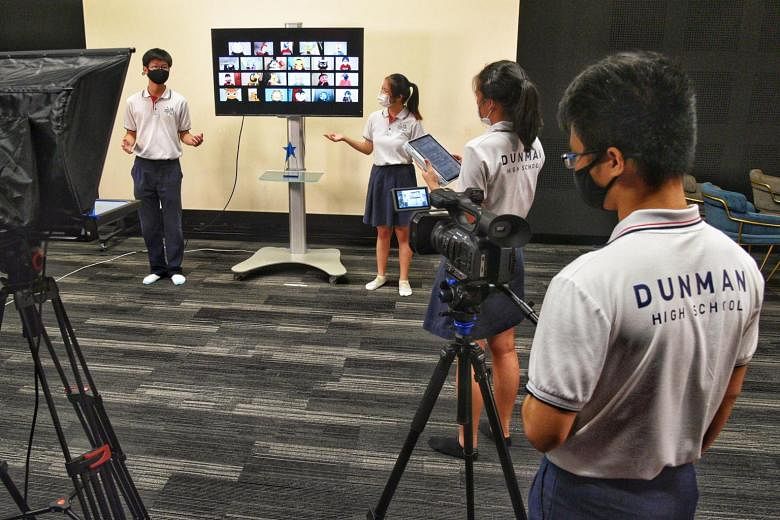SINGAPORE - Most co-curricular activities (CCAs) have resumed in-person sessions, but doing so for a school choir of more than 60 students has been rather tricky.
To date, only five singers are allowed to sing together unmasked at a time.
To adapt to the rule, students from Dunman High School's choir take turns to attend physical practices weekly based on a roster, while the rest tune in from home on video-conferencing platform Zoom.
The choir is also in the midst of recording individual members' voices which will be pieced together digitally and submitted for this year's Singapore Youth Festival (SYF) Arts Presentation - a departure from singing together on stage for the biennial event.
Mr Adrian Ong, the choir's teacher-in-charge, said: "We used to have a standard way of looking at choir and the performing arts. But Covid-19 has really challenged us to think out of the box.
"Considering the circumstances, we're still trying to have meaningful learning opportunities for the students, be it through cultural exchange or music creation."
Overseas trips are out of the question, but the choir still embarked on a virtual exchange programme last December with students from the Packer Collegiate Institute Choir in New York.
Mr Ong added: "It's our first time doing a virtual exchange, and we had to coordinate the timing of the sessions because of the different time zones."
The students from both sides have met on Zoom to get to know each other through ice-breakers and self-introductory videos, as well as worked on songs and music composition activities together.
The exchange will culminate in a combined video performance made by stitching together individual recordings from both choirs.
Secondary 3 student Shernice Ng, who is in Dunman High School's choir, said: "It took us some time to figure out how to have CCA online in the past year."
After CCA came to a halt in March, her choir practices resumed online in July last year .
Students met the coaches and teachers on Zoom, and were sent to "breakout rooms" to practice in smaller groups.
Said Mr Ong: "It was challenging to hear each other over the platform, but at least the students got to sing from home."
Shernice, 15, said: "It was a good time for self-development at home listening to ourselves sing. We could better reflect on areas of improvement, explore vocal techniques and what we can do with our voices."
But nothing beats singing together in person, she added.
"An important element of a choir is creating harmony with different parts, and that is kind of lost when we can't sing with each other."
Shernice, who is also the choir's assistant student conductor and helps to conduct sectionals, said: "It can be quite difficult to check everyone's notes and vocal techniques over Zoom."
Being able to sing together unmasked - even if it is only up to five individuals at a time - has been beneficial, she said.
"It may be a small step, but it definitely helps because we can hear each other better and work on making the best music possible."
As of April 7, student activities involving singing or voice training may have up to 30 participants in a class, including instructors.
If singing is conducted during the session, only the same five singers may be unmasked throughout, but masked singing by other participants is now allowed.
Said Mr Ong: "This is better as I can now have the rest of the choir members in the same venue joining in the singing, although it's not the full choir."
He added: "Covid-19 has shaken us to rethink what is important to us. At the end of the day, I see my students take pride in the entire process and I see their creativity despite all the constraints."


